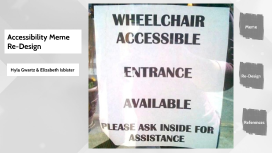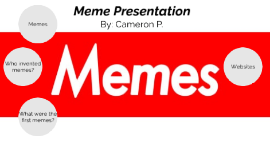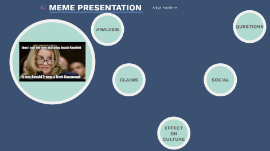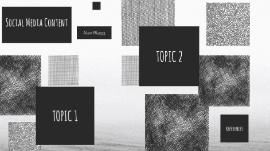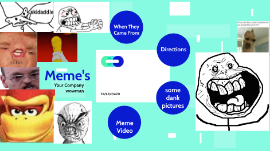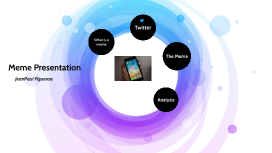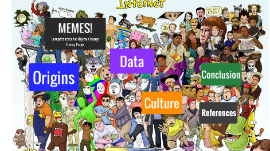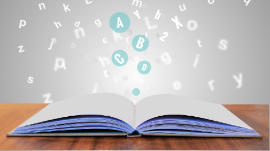Meme Presentation
Transcript: MEMES! Competencies for Digital Change Henry Paige Origins & Theory Origins Meme noun : An idea, behavior, style, or usage that spreads from person to person within a culture Richard Dawkins (1976) Observed processes in ideas similar to those in genetics: replication, mutation, selection pressure etc. Biology? "Memes (discrete units of knowledge, gossip, jokes and so on) are to culture what genes are to life. Just as biological evolution is driven by the survival of the fittest genes in the gene pool, cultural evolution may be driven by the most successful memes" Richard Dawkins, The Selfish Gene Some Historical Examples History Memento Mori: "Remember to die" A popular motif across art, particularly in Europe during the renaissance and enlightenment. Themes: Death, Fragility, Transience Epics Long narrative poems usually featuring the journey of a hero Themes: Struggle, Transformation, Identity Memento Mori 2nd Century AD Naples National architectural Museum Cornelis Norbertus Gysbrechts, "Vanitas Still Life" 17th Century AD Boston Museum of Fine Arts Epic Poems ~300 BC Mahabharata ~2000 BC Epic of Gilgamesh 1320 AD Divine Comedy Who made the first real "meme" as we know it? No clear answer, so here's two examples: Internet All your Base (Zero Wing, 1992) All your base (2002) First "macro" image: white text on black outline Dancing Baby (Autodesk, 1996) Dancing Baby (Late 1990s) One of the first "viral" videos, originally developed to show the physics capabilities of 3D Studio Max https://giphy.com/gifs/baby-internet-vintage-14kqI3Y4urS3rG Memes as a Data Phenomenon Memes can convey information quickly, often using easy-to-understand image formats and humorous or memorable taglines. Data Meme Symbolism Symbolism The choice of images, text and even colors can shape perceptions. In this example, the simple, strong font conveys austerity and stoicism. The red and white are easy to read and evoke the british flag. Finally, the crown reigning from the top symbolizes a rallying point for the people. British Ministry of Information Summer 1939 Viral Processes Viral Marketing Similar to viruses: Contagious Self-sustaining Spread Rapidly August 2019:Popeyes VS Chik-fil-a Chik-fil-a took a stab at Popeyes on twitter after the latter released a similar sandwich. After a 15 minute flash meeting, Popeye's twitter staff made history with the immortal "...y'all good?". The internet exploded with people posting their favorite sandwiches and starting a buzz which benefited both companies to the point of shortages Chicken Sandwich Wars You cant force memes... Given the immense popularity and reach of memes, there have been countless attempts to "harness" memes. Here are a few poorly-received examples: Viral Fails USHHS posts "doge" format incorrectly, using eye-burning colors and fonts Pepsi's infamous ad showing Kendall Jenner defusing a BlackLivesMatter protest with some soda... Why doesn't it usually work? Memes are the products of the internet, and consequently embody many of its traits and values. Consequently, many people are put off by the "freedom" and randomness of memes being infringed by corporate or government interests Memes can transcend cultural, linguistic and geographical boundaries Culture Simple, humorous and relatable, memes are easily spread on the internet Like a Boss! Originally a reference to a music video, this meme appeals to the human sense of accomplishment and being cool. Russia USA India Corona Memes Solidarity Location 3 As NCov19 becomes a global problem, we can use the internet to share and celebrate our shared experiences! Harlem Shake Harlem Shake A viral video series featuring spontaneous dancing to a Baauer song. Some people even organized massive "flash mobs" with hundreds of people! The video link below features some of the best ones, from firefighters to office workers: https://www.youtube.com/watch?v=8f7wj_RcqYk The nasty side of memes Dark Side Just as memes enable the rapid transmission of jokes and stories, they can also be used to reinforce prejudice, hatred and misinformation Bullshit facts The fast-paced nature of the internet allows information to quickly duck fact-checking, verification and even intelligent discussion! Pseudoscience Memes can create dangerous feedback loops Polarization Internet communities are particularly prone to "echo chambers" where the same ideas are recycled and reinforced. This can lead to increasing ignorance and hostility among people with different views. This was especially during the 2016 US presidential election, with "shitposts" flooding in from both sides Key Takeaways Conclusion Memes represent ideas which transmit and behave like genes Memes represent a powerful tool for propaganda, marketing and distributing information Memes often feature a shared human experience or belief Memes are often random, spontaneous and difficult to predict Memes can bring people together, or be used destructively Questions? Some things to get the ball rolling...






